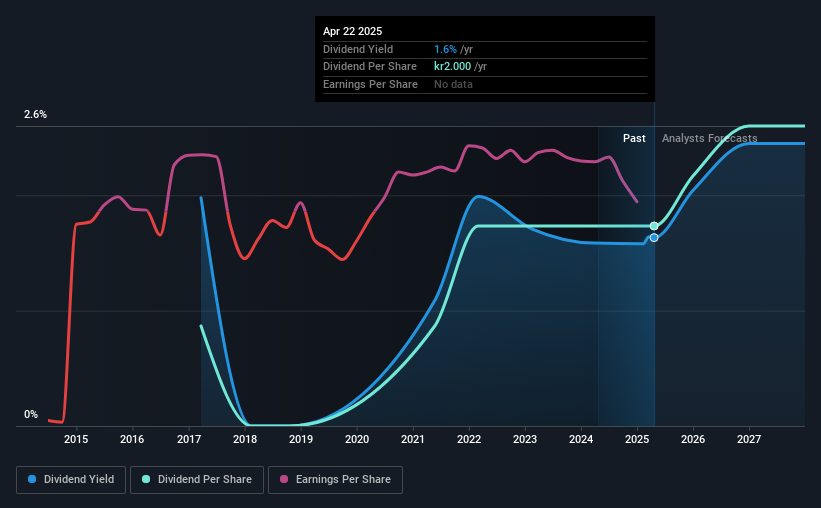The board of Studsvik AB (publ) (STO:SVIK) has announced that it will pay a dividend of SEK2.00 per share on the 2nd of May. This means the annual payment will be 1.6% of the current stock price, which is lower than the industry average.
Our free stock report includes 1 warning sign investors should be aware of before investing in Studsvik. Read for free now.Studsvik's Future Dividend Projections Appear Well Covered By Earnings
It would be nice for the yield to be higher, but we should also check if higher levels of dividend payment would be sustainable. Before this announcement, Studsvik was paying out 171% of what it was earning, and not generating any free cash flows either. Paying out such a large dividend compared to earnings while also not generating any free cash flow would definitely be difficult to keep up.
Analysts expect a massive rise in earnings per share in the next year. Assuming the dividend continues along recent trends, we estimate that the payout ratio could reach 22%, which is in a comfortable range for us.

View our latest analysis for Studsvik
Studsvik's Dividend Has Lacked Consistency
Looking back, Studsvik's dividend hasn't been particularly consistent. This makes us cautious about the consistency of the dividend over a full economic cycle. Since 2017, the dividend has gone from SEK1.00 total annually to SEK2.00. This implies that the company grew its distributions at a yearly rate of about 9.1% over that duration. A reasonable rate of dividend growth is good to see, but we're wary that the dividend history is not as solid as we'd like, having been cut at least once.
Studsvik Might Find It Hard To Grow Its Dividend
With a relatively unstable dividend, it's even more important to evaluate if earnings per share is growing, which could point to a growing dividend in the future. It's encouraging to see that Studsvik has been growing its earnings per share at 16% a year over the past five years. However, the payout ratio is very high, not leaving much room for growth of the dividend in the future.
The Dividend Could Prove To Be Unreliable
Overall, we don't think this company makes a great dividend stock, even though the dividend wasn't cut this year. While we generally think the level of distributions are a bit high, we wouldn't rule it out as becoming a good dividend payer in the future as its earnings are growing healthily. We would probably look elsewhere for an income investment.
It's important to note that companies having a consistent dividend policy will generate greater investor confidence than those having an erratic one. Meanwhile, despite the importance of dividend payments, they are not the only factors our readers should know when assessing a company. For instance, we've picked out 1 warning sign for Studsvik that investors should take into consideration. If you are a dividend investor, you might also want to look at our curated list of high yield dividend stocks.
New: Manage All Your Stock Portfolios in One Place
We've created the ultimate portfolio companion for stock investors, and it's free.
• Connect an unlimited number of Portfolios and see your total in one currency
• Be alerted to new Warning Signs or Risks via email or mobile
• Track the Fair Value of your stocks
Have feedback on this article? Concerned about the content? Get in touch with us directly. Alternatively, email editorial-team (at) simplywallst.com.
This article by Simply Wall St is general in nature. We provide commentary based on historical data and analyst forecasts only using an unbiased methodology and our articles are not intended to be financial advice. It does not constitute a recommendation to buy or sell any stock, and does not take account of your objectives, or your financial situation. We aim to bring you long-term focused analysis driven by fundamental data. Note that our analysis may not factor in the latest price-sensitive company announcements or qualitative material. Simply Wall St has no position in any stocks mentioned.
About OM:SVIK
Studsvik
Provides technical solutions across the nuclear and radioactive material lifecycle in Sweden, Germany, rest of Europe, Asia, North America, and internationally.
Reasonable growth potential with mediocre balance sheet.
Market Insights
Community Narratives



